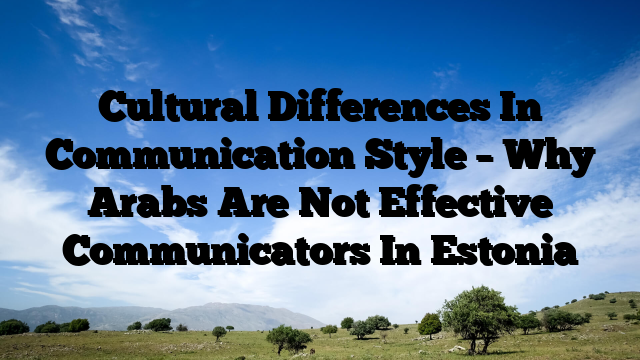We all know that our success in life depends heavily on how well we can communicate. New immigrants often believe that learning vocabulary and grammar will make them effective communicators in Estonia and solve all problems. In the long term, however, they realize that they have misunderstandings and conflicts everywhere. By observing cultural differences in communication styles and practices of new immigrants in Estonia and other European countries, I have documented several cultural differences that lead to conflict and misunderstanding rather than success.
Recently we saw a case in the media where a group of Arabs tried to change their driving licenses in Estonia but instead caused a media event by threatening officials. The main reason for the conflict was that although the Arabs spoke Estonian, they used a completely different style of communication than the Estonians. It was really interesting to see how the officials tried to explain the regulations according to their own direct communication style, but since Arabs and Estonians have very different listening and speaking habits, Arabs did not understand the message, but perceived it as unfriendly behavior and responded with it threats. For Estonians, on the other hand, it is difficult to understand that loud and raised speaking could express sincerity in other cultures and that they therefore usually perceive it as aggressive behavior.
There are huge cultural differences in low and high context communication, how to approach other people, how to say what is relevant, in body language, in direct and indirect communication styles, and in values and norms. Officials analyzing the situation claimed that Arabs didn’t listen to them, talked about irrelevant things, disobeyed rules and threatened officials. Customer service agents usually claim that Arabs don’t understand the meaning of the word “no”, they don’t understand that it really means that “something is not possible”. They seem to think they just need to explain longer and come back the next day with a larger group and speak louder. In my experience, Arabs in Estonia tend to use the same communication behavior over and over again in different situations, although they never reach their goal.
Arabic and Estonian cultures can be differentiated in terms of direct and indirect styles of communication. Estonian cultural preference is for clear and direct communication, as evidenced by common expressions such as “Ara keeruta!” (Don’t beat around the bush), “Räägi asjast! (Get to the point). As we can see from these two examples, Estonians use even fewer words to express these phrases than English speakers, which means that they really prefer to get to that point as quickly as possible without wasting time, because that’s how they feel when someone talks too much about “irrelevant” things. In high-context communication (like Arabic), much of the “burden of meaning” seems to lie on the listener. In low-context cultures (like Estonian), the onus seems to be to accurately and thoroughly convey meaning in the spoken or written message to lie with the speaker (Hall, 1976) the indirect message and perceive it as a waste of time I have seen many conflicts arise simply because a person from another culture talks too much and for too long.
The direct style strives to present facts accurately and avoids emotional overtones and suggestive allusions. In contrast, the indirect communication style more common among Arabs is ambiguous and emotionally rich. The desire for precision is not as important as creating emotional resonance. It is difficult for Estonians to understand that in other cultures speaking loudly and with a rising pitch could express sincerity and therefore they usually perceive it as aggressive and hostile behavior.
Although Arabs are considered representatives of the indirect style of communication, in many ways the Arabic language seems to be much more direct than English or Estonian. For example, in Estonian you can’t say to someone “I want that!” or “You have to do this!”. Instead, it is often paraphrased as a question or used conditional moods such as “Ma sooviksin…” (I would like…), “Kas oleks võimalik/kas ma saaksin…?” (Would it be possible/ could I…?). In these cases, Arabs tend to use a fairly direct form of address according to Arabic language structure, which can shock officials, customer service staff, as well as everyone else in Estonia, because it sounds aggressive. In addition, as in the German language, there are familiar and polite forms of saying “du” (Sina – Du, Teie – Sie) and in the official context of communication between strangers, only the polite form is always used, as it allows distance uphold and show respect. This is certainly another reason why Estonians view Arabs’ communication style as aggressive.
So far we have only trained civil servants and customer service agents on these issues to reduce intercultural conflicts in Estonia, but this does not make new immigrants more successful communicators. In ordinary language courses, language teachers are not aware of cultural differences in communication styles and cannot teach these skills. The Estonian language course books are not designed to teach intercultural communication or how to become successful in business and life. For this reason, it is important to offer seminars and training materials for new immigrants to raise their cultural awareness and teach them how to achieve their communication goals in Estonia.
Thanks to Ulle Rannut | #Cultural #Differences #Communication #Style #Arabs #Effective #Communicators #Estonia
